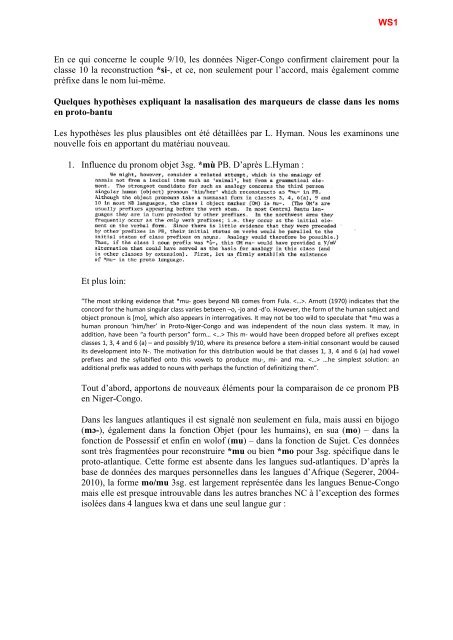here - 5th International Conference on Bantu Languages
here - 5th International Conference on Bantu Languages
here - 5th International Conference on Bantu Languages
You also want an ePaper? Increase the reach of your titles
YUMPU automatically turns print PDFs into web optimized ePapers that Google loves.
En ce qui c<strong>on</strong>cerne le couple 9/10, les d<strong>on</strong>nées Niger-C<strong>on</strong>go c<strong>on</strong>firment clairement pour la<br />
classe 10 la rec<strong>on</strong>structi<strong>on</strong> *si-, et ce, n<strong>on</strong> seulement pour l’accord, mais également comme<br />
préfixe dans le nom lui-même.<br />
Quelques hypothèses expliquant la nasalisati<strong>on</strong> des marqueurs de classe dans les noms<br />
en proto-bantu<br />
Les hypothèses les plus plausibles <strong>on</strong>t été détaillées par L. Hyman. Nous les examin<strong>on</strong>s une<br />
nouvelle fois en apportant du matériau nouveau.<br />
1. Influence du pr<strong>on</strong>om objet 3sg. *mù PB. D’après L.Hyman :<br />
Et plus loin:<br />
WS1<br />
“The most striking evidence that *mu- goes bey<strong>on</strong>d NB comes from Fula. . Arnott (1970) indicates that the<br />
c<strong>on</strong>cord for the human singular class varies betxeen –o, -jo and -d’o. However, the form of the human subject and<br />
object pr<strong>on</strong>oun is [mo], which also appears in interrogatives. It may not be too wild to speculate that *mu was a<br />
human pr<strong>on</strong>oun ‘him/her’ in Proto-Niger-C<strong>on</strong>go and was independent of the noun class system. It may, in<br />
additi<strong>on</strong>, have been “a fourth pers<strong>on</strong>” form… This m- would have been dropped before all prefixes except<br />
classes 1, 3, 4 and 6 (a) – and possibly 9/10, w<str<strong>on</strong>g>here</str<strong>on</strong>g> its presence before a stem-initial c<strong>on</strong>s<strong>on</strong>ant would be caused<br />
its development into N-. The motivati<strong>on</strong> for this distributi<strong>on</strong> would be that classes 1, 3, 4 and 6 (a) had vowel<br />
prefixes and the syllabified <strong>on</strong>to this vowels to produce mu-, mi- and ma. …he simplest soluti<strong>on</strong>: an<br />
additi<strong>on</strong>al prefix was added to nouns with perhaps the functi<strong>on</strong> of definitizing them”.<br />
Tout d’abord, apport<strong>on</strong>s de nouveaux éléments pour la comparais<strong>on</strong> de ce pr<strong>on</strong>om PB<br />
en Niger-C<strong>on</strong>go.<br />
Dans les langues atlantiques il est signalé n<strong>on</strong> seulement en fula, mais aussi en bijogo<br />
(mɔ-), également dans la f<strong>on</strong>cti<strong>on</strong> Objet (pour les humains), en sua (mo) – dans la<br />
f<strong>on</strong>cti<strong>on</strong> de Possessif et enfin en wolof (mu) – dans la f<strong>on</strong>cti<strong>on</strong> de Sujet. Ces d<strong>on</strong>nées<br />
s<strong>on</strong>t très fragmentées pour rec<strong>on</strong>struire *mu ou bien *mo pour 3sg. spécifique dans le<br />
proto-atlantique. Cette forme est absente dans les langues sud-atlantiques. D’après la<br />
base de d<strong>on</strong>nées des marques pers<strong>on</strong>nelles dans les langues d’Afrique (Segerer, 2004-<br />
2010), la forme mo/mu 3sg. est largement représentée dans les langues Benue-C<strong>on</strong>go<br />
mais elle est presque introuvable dans les autres branches NC à l’excepti<strong>on</strong> des formes<br />
isolées dans 4 langues kwa et dans une seul langue gur :


